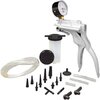Okay, so here's my best guess... The rear pedal doesn't seem to push any fluid into the system.
The rear master cylinder was working perfectly before I changed the SMC.
The SMC added air. I tried my brakes several times before removing all fluid then replacing.
Perhaps by using the brakes before I did "The Sequence", I introduced air into the rear master cylinder, rendering it ineffective, rendering all my operations ineffective...
What do you think...? This seems like a better explanation than foreign debris in the line.
If the master cylinder is indeed dry and not operational, how do I "prime" it...?
NOTE: The reservoir level does not change no matter how many times I operate the pedal (several hundred). This is why I'm guessing the master cylinder has been rendered ineffective.
What do you think?
Could also happen because of air in the lines.
If you decide to do the quick bleeder 4 test, keep pumping the pedal although you feel no resistance and observe if the level in the MC reservoir is going down or not while you pump.
Route your clear tube on the cracked bleeder 4 straight to a container as you do that, so you do not have to worry about what is happening at this end while you pump the pedal and observe the fluid level in the rear MC reservoir.
I tried just what you said. The reservoir does NOT go down. In fact, bit by bit, the reservoir raises.
It was 3/4 full to start, but now it is a couple mm from the top lip, so I stopped.
I ran into the reservoir overflowing several times (during day 1) during this process.
Seems counter-intuitive, to say the least.
No, the service manual states something like "If you use a vacuum, follow their instructions". It does not tell you to Use a vacuum.
This system can be bled manually with just a hose, 8 mm wrench, and a catch bottle, by using the levers.
Yes, I reread...
"Attach a commercially available air bleeder"
I took this to mean a vacuum, since that is what the local guy used who replaced my rear brake pads last year.
Vacuum, or no vacuum, the pedal does not seem to be pushing juice from the reservoir into the system. (See my response to MidLife above)


